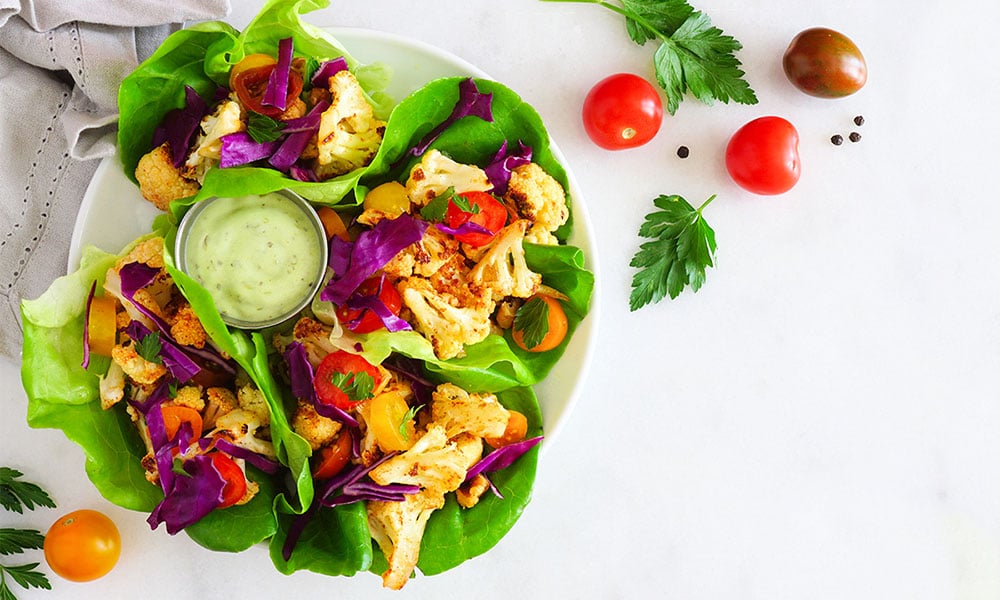Sometimes if you head to the farmer’s market toward the end of the day, prices are slashed because sellers do not want to haul perishable produce back home.
As a nutrition coach, you know it’s not wise to ignore what your clients put on their plates. How people fuel up can seriously affect their results and, in turn, their perception of your program and their success.
Reminding clients to make (and stick to) grocery lists is a good place to begin. But many people new to healthy eating may balk at the prices of things like fresh produce, nuts, and new foods made with plant proteins.
To help clients ease into healthy shopping without breaking the bank, try to work some of these wallet-friendly tips and tricks into your everyday banter (or address them in a more formal talk about nutrition).
Originally appeared in the Fall 2020 Issue of American Fitness Magazine (click to download). And, if you are interested, check out our list of classes on nutrition here.
Make a Plan—and Stick to It!
While clients may be used to shopping on the fly, you may want to suggest they begin by sitting down and really thinking about what they plan to buy. Planning out a week’s worth of meals may take a bit of effort, but the results are more than worth it. Not only will this allow your clients to plan for leftovers—hello, rotisserie chicken!—but it will keep people from running to the grocery store every few days.
That saves time and money and can cut back on the potential to impulse-buy. What’s more, clients will be much more likely to follow a healthy eating plan (and not splurge on a random lunch or dinner) if they’ve selected meals and snacks ahead of time.
Once those meals are planned out, the next step is to make a grocery list. Remind clients to commit to buying only what is on the list. This will give them additional protection from often-unhealthy impulse buying—good for both wallet and waist. For people who really struggle to keep their cart on track, online grocery shopping may be a better bet, if it’s available where they shop.
Now that clients know what they need, it’s time to get it and bring it home. Offer a few (or all) of these tips and the rationale behind why they help keep spending in check.
Buy Whole Foods
You can save a lot of money by doing your own prep work in the kitchen! Processing and packaging foods adds expense, plus consider all the marketing dollars put in by the manufacturer. It’s the consumers who pay a premium for that time and effort. Another perk of less-processed options: They often come in larger packages, making the “cost per serving” lower.
Invite clients to do a quick comparison in the store: Look at the difference in cost between a 1-pound bag of whole carrots and a 1-pound bag of carrots that are already peeled and sliced. Or how about a block of cheddar versus a bag of shredded cheese? Not only is the cost per serving lower, but the whole food will last longer and will often taste better as well.
Buy in Bulk
This is one of the simplest suggestions you can make to clients. Many items—including whole grains, oats, dried legumes, nuts and seeds—can be found in the grocery store’s bulk aisle (although many grocery stores temporarily stopped offering bulk bin items during the pandemic).
Buying in this way can definitely decrease grocery bills, because clients can buy only as much as they want, rather than getting a predetermined amount of each item. Another simple tip: Recommend that people use these healthy staples to create their own trail mix. Then, to keep portions in check, they can divide the mix into individual servings using small plastic containers.
Buy in Season
Fresh produce is vital to healthy eating, but the cost can add up quickly. Look to see what is in season at both your grocery store and the local farmer’s market. And here’s a tip: Sometimes if you head to the farmer’s market toward the end of the day, prices are slashed because sellers do not want to haul perishable produce back home.
If you end up with a big haul of fruits and vegetables but won’t make it through all of them, you can easily freeze them for up to 6 months, using little bits along the way. There’s nothing like eating those gorgeous summer berries throughout the fall and winter!
Buy Frozen and Canned Produce
Fresh fruits and vegetables are not the only healthy versions of produce! Frozen and canned items play a role as well. In fact, having these on hand at all times may save clients a midweek trip to the store (if they forgot an ingredient or ran out of fresh options). That can save time and money and (again) avoid less-than-healthy impulse buys. Frozen fruits and vegetables are picked at their peak and frozen within 24 hours, making them both tasty and nutritious. Canned choices can be healthy, too, if clients are careful to opt for ones with low sodium and no added sugar.
Some ideas for using frozen vegetables: Sauté or roast them, or add them into sauces and stews. Frozen fruit is always great for a smoothie and can be easily used as a topper for pancakes, oatmeal or yogurt (the same is true of the canned version). As for canned or jarred vegetables, artichoke hearts are a delicious side dish when sautéed with olive oil, salt, pepper and lemon juice, and canned beans can amp up the protein and fiber in a grain salad or stew.

Planning out a week’s worth of meals will keep clients from running to the grocery store every few days. That saves time and money.
Buy Dried Beans and Legumes
As good sources of plant-based protein, dried beans and legumes (like lentils) are some of the most nutritious and affordable options available at the grocery store. These can be purchased in 1-pound bags or in smaller portions in the bulk section. People who get in the habit of cooking a batch every week come to appreciate the never-ending versatility of these foods!
Add them to soups, stews and chilis, or throw them into a salad. How about a quick purée with some olive oil, salt, pepper and lemon juice for a bean dip or sandwich spread? And my personal favorite: Roasting beans like chickpeas in the oven makes for a crunchy, savory snack.
Choose Animal Protein Wisely
When buying meat, poultry and seafood, look for cuts that are less expensive, such as chicken thighs versus chicken breasts. Roasting an entire chicken and then using it for the week in a variety of meals is a perfect way to spend less per pound and get the most out of an ingredient for the week. Cheaper cuts of meat, such as beef chuck or pork shoulder, can be thrown into a slow cooker and braised to perfection overnight. A large batch of pulled pork can provide several meals throughout the week and can also be frozen in portions and eaten for the next 3 months.
When choosing seafood, look to the canned aisle or the frozen section. Canned fish, such as tuna and salmon, provides essential fatty acids and nutrients, which are an important part of a healthy diet. Adding tuna to a salad or making salmon cakes is an easy and affordable way to incorporate more seafood into your diet. The freezer section may also have pre-portioned frozen pieces of fish, such as salmon or cod. These are great to keep in your freezer; they thaw fast and can be cooked stovetop or roasted in the oven fairly quickly.
And don’t forget the incredible edible egg! With 6 grams of protein and 13 essential vitamins and minerals per large egg, this delicious ingredient goes a long way. Add a fried egg onto leftover sautéed vegetables, make scrambled-egg tacos, or how about pita pizza with an egg on top? (Also check out the Savory Oats With Fried Egg recipe on page 63.)
Make the Most of Meat Extenders
Meat extenders boost flavor and nutrients and are very economical. Essentially, these ingredients bulk up a meal so that higher-priced items, like meat, can be used in smaller portions. And here’s the best part: Lean animal proteins may never taste dry or overcooked again, because these plant-based goodies add and retain moisture. Here are some of my go-to meat extenders:
MUSHROOMS
Mushrooms add umami, which is often characterized as “meatiness.” In addition to dietary fiber, mushrooms add a healthy dose of B vitamins, selenium and, in some cases, vitamin D. To try, swap out half the ground meat in a dish with 8–16 ounces of chopped mushrooms. They shrink when cooked, so the amount you want to use is ultimately based on your personal preference. (See page 56 for a burger recipe using a blend of mushrooms and meat.)
LENTILS
Lentils also make for a great meat mix-in. They come in a wide variety of colors and textures, and all of them are a good source of plant-based protein, fiber and iron. Some easy ideas: Add cooked lentils to ground meat in a sauce, chili or stew, or purée them in a food processor and use them in meatballs or meatloaf. (To most closely mimic ground meat, choose the brown variety.)
WHOLE GRAINS AND SEEDS
Adding chia seeds, rolled oats, bulgur or quinoa to meat adds volume and a range of nutrients, including fiber, B vitamins and plant-based protein. Add about 1 cup of cooked whole grains per pound of raw meat. Uncooked rolled oats make a great addition to burgers, while 1 tablespoon of chia seeds mixed with 21/2 tablespoons of water is the perfect proportion per pound of raw ground meat.
A Final Thought on “After-Market Value”
For clients who aren’t used to having to “use up” fresh foods in a timely manner, this tip is key: Keep an eye on expiration dates! If certain leftovers or produce are on the verge of going bad, encourage clients to think about ways to upcycle them, rather than throwing them out. For example, some types of produce can be frozen or used to make stock, soup, stew or a frittata.
Bottom line: The more you can help clients minimize the impact of healthy eating on their bottom line, the better. They will be more likely to stick with the plan and, in turn, see results sooner and reap even greater benefits than they could from fitness alone. And that will be deliciously satisfying for them and for you.
A Day of Healthy Eating: Sample Meal Plan & Recipes

To help clients see how easy and affordable healthy eating can be, I invite you to copy and share the suggestions below. Note: The videos for these recipes (and more!) can be found on chefabbiegellman.com.
Sample Meal Plan
Meal planning doesn’t have to be complex, and neither do healthy recipes! The proof is in the pudding—or in this case, the parfait! Here’s a day’s worth of dishes that are totally doable for almost anyone:
Breakfast: Savory Oats With Fried Egg. Recipe below.
Lunch: Grain Vegetable Salad With Tuna and Vinaigrette.
In a bowl, toss 1/2 cup chopped vegetables, 1 cup mixed greens and 1/2 cup cooked brown rice. To make the vinaigrette, whisk together 1 Tbl of olive oil, 1 Tbl of vinegar or citrus juice, and a pinch each of salt and pepper. Toss the dressing with the salad, then top with a 5-ounce can of (drained) tuna.
Snack: Fruit and Nut Butter. Piece of fruit (example: apple or pear) and 2 Tbl nut butter.
Dinner: Lentil Bolognese With Zucchini Noodles. Recipe below.
Snack/Dessert: Easy Yogurt Parfait. Mash ½ cup of plain yogurt with ½ cup fresh berries, then top with 2 Tbl chopped nuts. Optional: Add touch of honey or maple syrup.
Recipes
SAVORY OATS WITH FRIED EGG
This hearty breakfast is a great way to use up leftover vegetables, so don’t be afraid to mix and match. Use whatever veggies you like! Makes one serving.
3/4 cup water
1/4 cup dry quick-cooking steel-cut oats (or 1/2 cup cooked steel-cut oats or rolled oats)
pinch of salt
pinch of pepper
2 tsp extra-virgin olive oil, divided
1/4 cup red pepper, diced
1/4 cup zucchini, diced
2 Tbl onion, diced
1/4 cup kale, chopped
1 large egg
1. Bring water to boil. Add oats, reduce heat to low, and simmer for about 3 minutes, until all liquid is absorbed. Turn off heat and stir in salt and pepper.
2. Heat nonstick pan or skillet over medium-high heat, then add 1 tsp oil. Add vegetables and cook for 2–3 minutes, until softened. Spoon vegetables over cooked oats.
3. Add remaining 1 tsp oil to nonstick pan, then add egg. Cook until egg white is no longer translucent. Serve over oatmeal and vegetables.
LENTIL BOLOGNESE WITH ZUCCHINI NOODLES
Even meat lovers will love this plant-based twist on an old favorite. Feel free to swap in whole-wheat noodles, especially if you have some left over! To make it quicker, use canned cooked lentils (drained) instead of the dried version. Makes four servings.
2 Tbl extra-virgin olive oil
2 carrots, peeled and diced
1 onion, diced
1 stalk celery, diced
1/2 tsp salt
1 cup dried lentils, rinsed
1 (14.5 oz) can diced tomatoes
4 cups vegetable broth
1∕8 tsp black pepper
2 Tbl plain Greek yogurt
1 Tbl balsamic vinegar
zucchini noodles (zoodles)
1. Heat soup pot or deep pan over medium heat and add oil. Add carrots, onions, celery and salt. Sauté until translucent or slightly golden, about 8–10 minutes.
2. Add lentils, tomatoes and broth, and bring to a boil. Lower to a simmer and leave until lentils are cooked through, about 25–30 minutes.
3. Mix in pepper, yogurt and vinegar. Continue to simmer until sauce reaches desired thickness.
4. About 3–4 minutes before ready to eat, boil zucchini noodles until desired doneness. To serve, top cooked zoodles with sauce.
Nutrition Education–Tapas-Style: Mini Courses for the Epicurious
Sometimes it’s easier to digest nutrition information in small bites. That’s why the National Academy of Sports Medicine recently launched the NASM Nutrition Series, which offers short 4-lesson courses that are open to fitness professionals and clients alike! (You and your clients can even take these courses simultaneously and discuss the lessons in your sessions.) Each of the digital courses, created by a team of industry experts, includes lessons, a video, visual learning aids, and a course-completion quiz and certificate all at a cost of only $49.
Currently on the menu:
• Food Labels and Portion Sizes
• Making Sense of Supplements
• Navigating Diets
• Nutrition Hot Topics and Controversies
• Plant-Based Diets
To learn more about any of these, as well as the extensive NASM Certified Nutrition Coach course for fitness professionals, visit our all nutrition courses page.
















